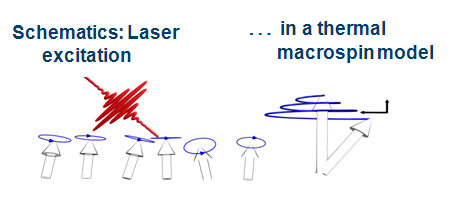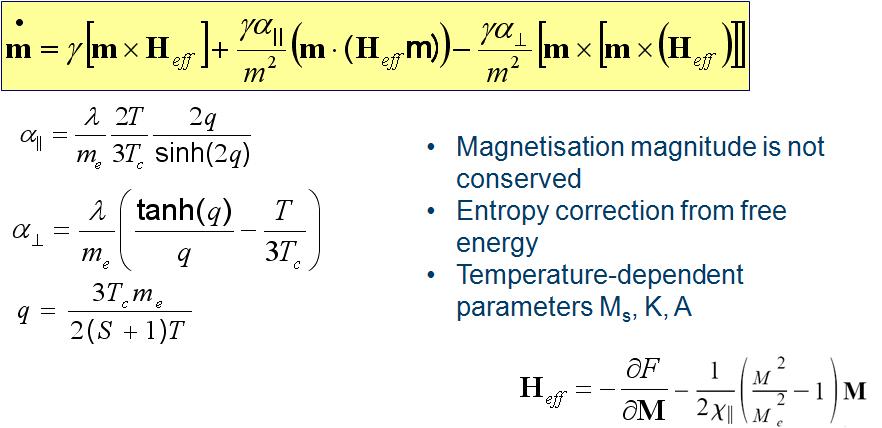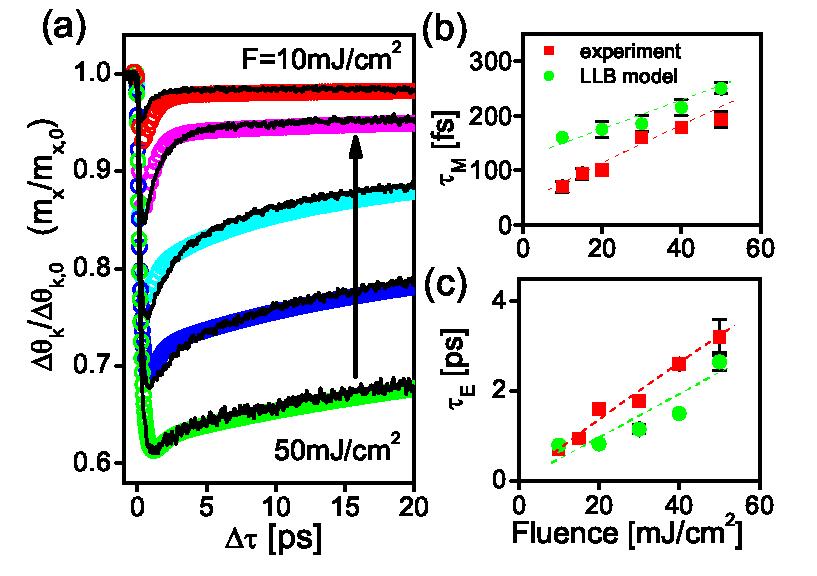Modelling of ultra-fast laser-induced magnetisation dynamics
Recent pump-probe experiments with powerful femtosecond lasers have pushed the limits of spin manipulation down to femto-pico second timescale. The microscopic processes responsible for the ultrafast changes in the macroscopic magnetization of the ferromagnetic materials have not been unambiguously identified yet. These scattering events lead to the energy flow between different subsystems: phonons, electrons and spins. Two possible candidates for microscopic processes has been suggested: the Elliott-Yafet (mediated by phonons) and inelastic exchange electron scattering. This finally manifests itself as spin system excitation involving THz spin waves, its relaxation and fluctuations. Interestingly, only in a ferrimagnetic compound FeCoGd controllable magnetisation switching under laser excitation has been reported. Recently, we have shown that the magnetisation switching can occur in this material under the ultra-fast heat alone [7].
For the modelling of ultra-fast laser-induced magnetisation dynamics we use a two-temperature model involving the electron and phonon heat baths dynamics. For magnetisation dynamics we use several approaches:
(a) Langevin dynamics simulations for localized atomistic spins based on the Landau-Lifshitz-Gilbert equation. Here recently we have introduced a colored noise approach [1].
(b) Modelling of ultra-fast processes basing on the macroscopic Landau-Lifshitz-Bloch equation (LLB) equation [2-4]. The LLB equation has been derived by D.Garanin for a collection of classical spins [5] and from density matrix approach for quantum spins [6]. It contains two-temperature dependent magnetic relaxation: the transverse and the longitudinal. We have compared the modelling based on the LLB equation with experiments in Ni [3] and Gd [8].
We have recently derived classical LLB equation for two-component materials such as ferrimagnets [9].

Schematics of thermal macrospin model:The laser deposits energy on the spin system leading to the excitation of THz spin waves (left). The resulting "macrospin" (right) experiences two relaxations: longitudinal and transverse damping.

The (quantum) Landau-Lifshitz-Bloch (LLB) equation for a ferromagnet with spin S. The intrinsic coupling-to-the-bath parameter is defined by the spin-flip probability. There are two damping parameters longitudinal and perpendicular.
Femtosecond magnetization dynamics in the thermal macrospin (LLB) model by the numerical integration (symbols) and the experimental time resolved magnetization in Ni [3]. The right pannel represents the demagnetisation (upper) and the remagnetisation (lower) times.
References:
[1] U.Atxitia, O.Chubykalo-Fesenko, R.W.Chantrell, U.Nowak,and A Rebei “Ultra-fast spin dynamics: the effect of colored noise.”, Phys Rev. Lett. 102 (2009) 057203.
[2] U.Atxitia, O.Chubykalo-Fesenko, N.Kazantseva, D.Hinzke, U.Nowak and R.W.Chantrell “Micromagnetic modelling of laser-induced magnetisation dynamics using the Landau-Lifshitz-Bloch equation.”,Appl. Phys. Lett. 91 (2007) 232507.
[3] U.Atxitia, O.Chubykalo-Fesenko, J.Walowski, A.Mann and M.Munzenberg “Evidence for thermal mechanisms in laser-induced femtosecond spin dynamics”, Phys.Rev.B 81 (2010) 174401.
[4] U.Atxitia, O.Chubykalo-Fesenko «Ultra-fast magnetisation dynamics rates within the Landau-Lifshitz-Bloch model», Phys. Rev. B 84 (2011) 144414.
[5] D. A. Garanin, Phys.Rev. B 55 (1997) 3050.
[6]D.A. Garanin, Physica A 172 (1991) 470.
[7] T.Ostler et al ,Nature Commun. 3 (2012) 666.
[8] M.Sultan et al, Phys. Rev. B 85 (2012) 184407.
[9] U.Atxitia et al, Phys. Rev. B 86 (2012) 104414
